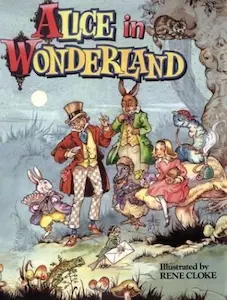Alice in Wonderland - Summary
Lewis Carroll

Introduction
“Alice in Wonderland” by Lewis Carroll is a timeless classic that has captivated readers for generations. This whimsical tale takes readers on a journey through a fantastical world filled with peculiar characters and nonsensical situations. Carroll’s imaginative storytelling and clever wordplay make this book a delightful and thought-provoking read. In this book summary, we will explore the key themes and characters in “Alice in Wonderland,” providing examples and anecdotes from the book to illustrate its enduring charm.
The Curious Adventure Begins
The story begins with young Alice, a curious and imaginative girl, who falls down a rabbit hole and finds herself in a strange and enchanting land. This initial encounter sets the stage for the whimsical and unpredictable nature of Wonderland. As Alice navigates through this topsy-turvy world, she encounters a myriad of eccentric characters, each with their own peculiarities.
The Mad Hatter’s Tea Party
One of the most memorable scenes in “Alice in Wonderland” is the Mad Hatter’s Tea Party. This chapter showcases Carroll’s talent for creating absurd and memorable characters. The Mad Hatter, the March Hare, and the Dormouse engage in a never-ending tea party, where time is stuck at 6 o’clock. This scene is filled with nonsensical conversations and riddles, creating a sense of chaos and confusion. Through this episode, Carroll satirizes the rigid social conventions of Victorian England, where time and etiquette were of utmost importance.
The Cheshire Cat’s Enigmatic Wisdom
Another iconic character in the book is the Cheshire Cat, known for its mischievous grin and disappearing act. The Cheshire Cat serves as a guide and mentor to Alice, offering enigmatic wisdom and thought-provoking insights. One of the most famous quotes from the book comes from the Cheshire Cat: “We’re all mad here. I’m mad. You’re mad.” This line reflects Carroll’s exploration of the concept of madness and the blurred lines between reality and imagination.
The Queen of Hearts and the Absurdity of Power
The tyrannical Queen of Hearts is a character that embodies the absurdity of power. With her constant demand for executions and her infamous catchphrase, “Off with their heads!”, the Queen of Hearts represents the arbitrary and irrational exercise of authority. Carroll uses this character to satirize the autocratic rulers of his time and to question the legitimacy of their power. The Queen’s obsession with croquet, played with flamingos and hedgehogs, further emphasizes the nonsensical nature of her rule.
Alice’s Growth and Self-Discovery
Throughout her journey in Wonderland, Alice undergoes a transformative experience. She encounters numerous challenges and obstacles that force her to question her own identity and beliefs. Alice’s encounters with the Caterpillar, the Mock Turtle, and the Duchess all contribute to her growth and self-discovery. Carroll uses these encounters to explore themes of identity, perception, and the fluidity of self.
The Power of Imagination and Nonsense
One of the central themes in “Alice in Wonderland” is the power of imagination and nonsense. Carroll celebrates the freedom of thought and the ability to question societal norms. The nonsensical wordplay and absurd situations in the book encourage readers to embrace their own creativity and to challenge conventional thinking. Through Alice’s adventures, Carroll reminds us of the importance of maintaining a childlike wonder and curiosity in our own lives.
The Influence of “Alice in Wonderland”
Since its publication in 1865, “Alice in Wonderland” has had a profound impact on literature and popular culture. The book has been adapted into numerous films, plays, and even video games. Carroll’s imaginative storytelling and vivid characters continue to inspire artists and writers to this day. The themes explored in the book, such as the nature of reality and the power of imagination, resonate with readers of all ages and have contributed to its enduring popularity.
Conclusion
In conclusion, “Alice in Wonderland” is a whimsical and thought-provoking tale that continues to captivate readers with its imaginative storytelling and memorable characters. Lewis Carroll’s exploration of themes such as identity, power, and the nature of reality make this book a timeless classic. Through Alice’s adventures in Wonderland, readers are reminded of the importance of embracing their own curiosity and imagination. “Alice in Wonderland” is not just a children’s book; it is a work of art that continues to inspire and delight readers of all ages.